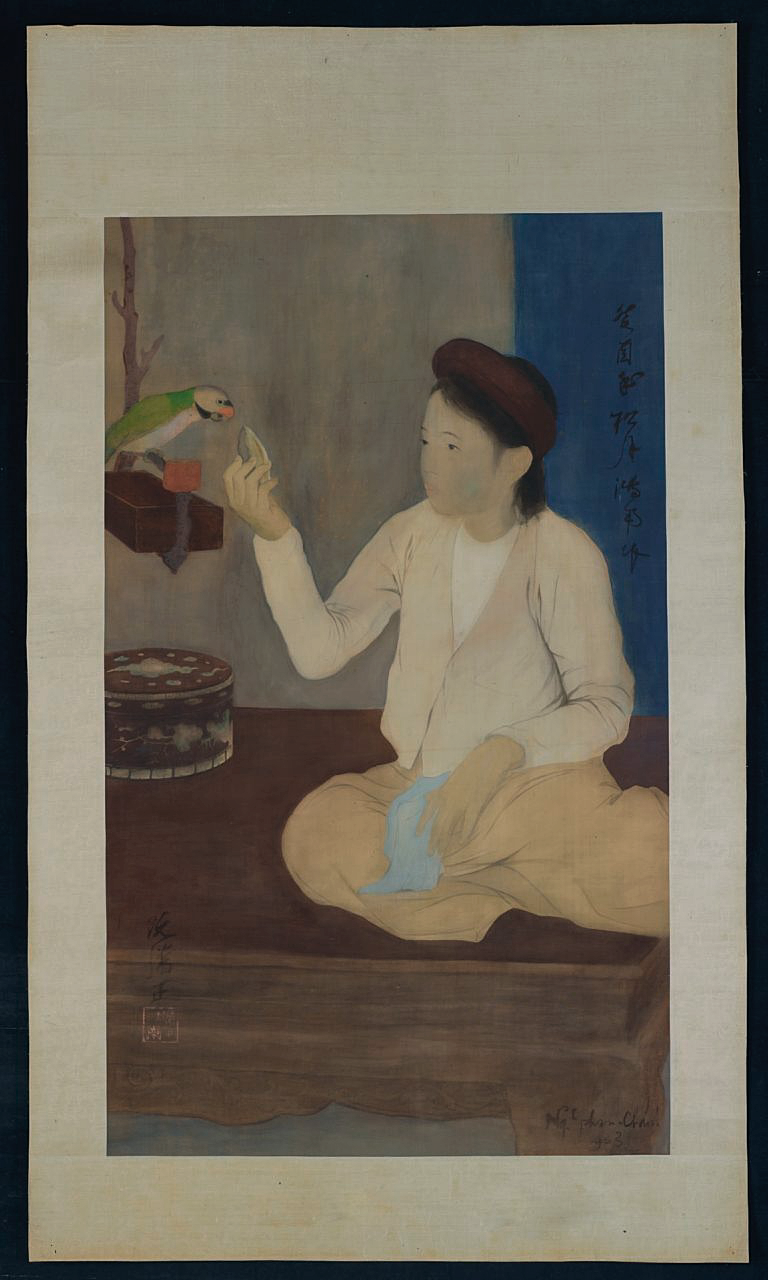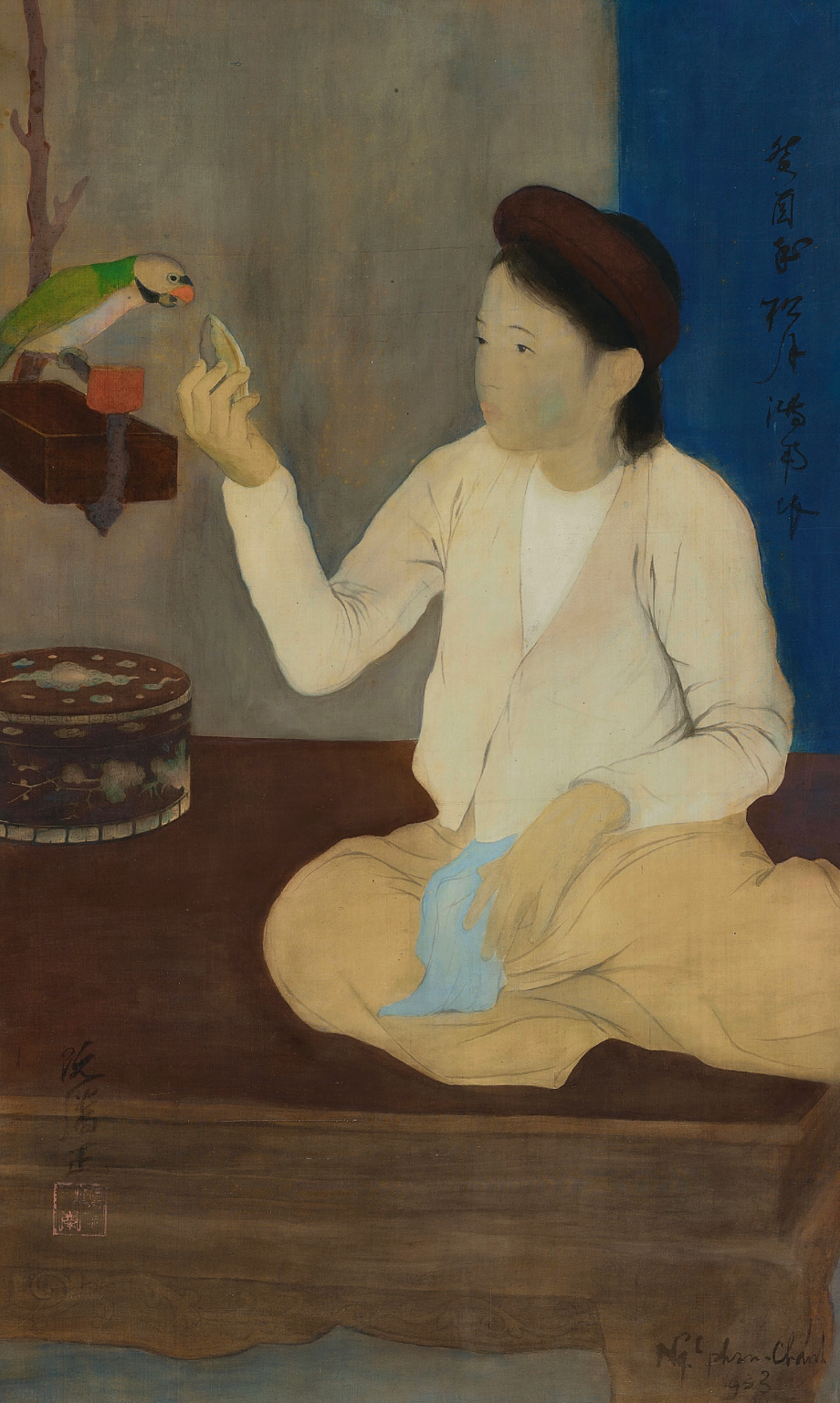
Nguyen Phan Chanh (Vietnam, 1892-1984)
Jeune fille au Perroquet (Young Girl with Parrot)
inscribed in Chinese (upper right); signed and dated 'Ng phan-Chanh 1933' (lower right); signed again in Chinese (lower left)
ink and gouache on silk in the original Gadin frame
82 x 49 cm. (32 1/4 x 19 1/4 in.)
Painted in 1933
one seal of the artist
Provenance
Acquired in France by the original owner
Thence by descent to the present owner
Price Realised HKD 3,485,000 at Christie's Hong Kong, 25 May 2019

By 1933, Nguyen Phan Chanh was already known to a wide audience: through his school in Vietnam, the Hanoi School of Fine Arts, which often organized exhibitions since 1929, and internationally, from 1931 onward, when l’Illustration, a famous publication at the time, wrote an illustrated article on the Paris Colonial Exhibition. Following this major event, the AGINDO (Indochina Economic Board) in Paris was in charge of exhibiting and promoting works by the best students of the Hanoi School of Fine Arts including Phan Chanh’s. As a result, many high quality works were sent to France and acquired by prestigious French art collectors.
However, and it is a known fact, the role of a collector is essential in building the success of any artistic endeavour. One can become an artistic mentor as demonstrated by our painting presented here: Indeed, a letter dated 24 October 1933, from Blanchard de la Brosse (Director of AGINDO) addressed to Victor Tardieu (Director of Hanoi School of Fine Arts) describes the French collectors’ tendencies and taste. When the French Minister at the time, Mr. Balinier, expressed his preference for a piece by Nam Son over the Devin by Nguyen Phan Chanh, Blanchard de la Brosse wrote in regret: “This incident confirms that the French art amateur has a strong leaning towards colour. No matter how evocative of Tonkin Phan Chanh’s works can be, and despite its remarkable quality, one can only come to the conclusion that they just don’t appeal to the public. It is desirable for this excellent artist to cultivate a palette of brighter colours (…)”
These few lines summarize the general feeling about Phan Chanh’s work and even some of the ‘new’ collectors would reproach the sombre ochre and muggy aspect of his work. One can expect that Tardieu would share these remarks with the artist which could explain the genesis of La jeune fille au perroquet. It is a truly extraordinary work where the artist moved away from his preferred classical monochrome set in a camaieu of brown for a more colourful chromatic range. On the other hand, he remained deeply faithful to his very own compositions, unusual and original, based on a clever use of geometry achieved by the application of subtle tones. The painting reveals a great sweetness, a mix of humility and dignity so characteristic to the painter’s work.
The young girl is depicted seated in the centre of the work on a large wooden bed, defined by horizontal and vertical lines complemented by a great blue rectangle in the background’s upper right corner. Nguyen Phan Chanh would very often use this triangular construction and this is well demonstrated here with the use of black ink in the headdress, the bird’s tub and also the use of dark brown in the round dark box decorated with mother-of-pearl motifs. The girl’s arms feeding the bird with sapota fruit also creates two open triangles. Three touches of colour reinforce the triangle effect: the blue panel, the tissue held in the left hand and the other triangle created by the parrot itself, the sapota fruit and the cup. Only the roundness of the decorated box with mother-of-pearl motifs breaks the angular effect, a choice often made by the artist.
For a painter used to depicting mostly rural trades and scenes of the common people, this interior scene is rare. The furnishing and the bird’s food in this interior demonstrates a high social class in this very subtle work kept in a very good condition and still in its original Gadin’s frame.
Our La jeune fille au perroquet is truly a masterpiece by Nguyen Phan Chanh.
Jean-Francois Hubert
Senior Expert, Vietnamese Art










